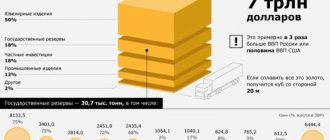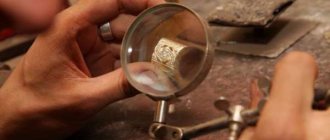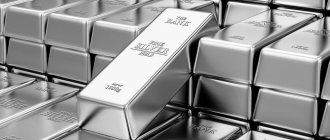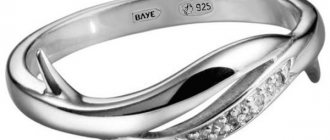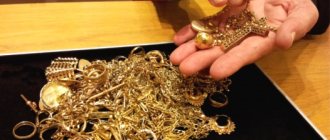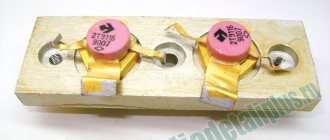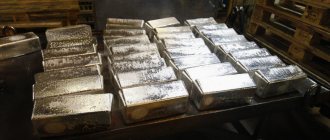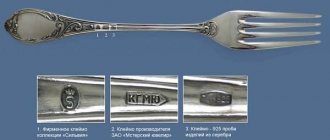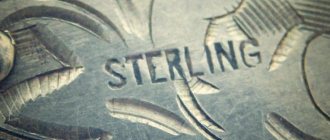Silver belongs to the category of precious metals.
Since time immemorial, together with gold, it has been used to make jewelry and luxury tableware, inlay weapons, decorate mirrors and decorate salon furniture.
Currently, the industrial use of silver has expanded significantly.
With the development of radio and electrical engineering, the widespread introduction of household television equipment, computers and various gadgets , the volumes of silver used every year in industrial production exceed 80% of the annual world silver production (10% is taken by jewelers, 8% by banks).
Replenishment of silver reserves is carried out not only through primary mining, but also through the processing of secondary raw materials.
What kind of silver is this
Strictly speaking, there is no such type of silver as “technical”. This is the name given to any silver alloy used not in jewelry, but in production.
Composition and properties
The main alloying component in a jewelry alloy is copper. The technical range is wider: cadmium, zinc, tin, nickel, and aluminum may be present. Their proportions are calculated based on the desired result.
Cadmium, zinc and tin lower the melting point, which makes alloys containing them valuable solders. True, cadmium makes the product more expensive, and zinc negatively affects its strength, so there are no universal solders - the composition is selected individually for the task.
Sources of recycled silver
The main sources of secondary silver are products from the electrical and radio engineering industries, printing, photography and film industries, products from the mirror, jewelry and watch industries.
From the household sector, sources of precious metal include scrap jewelry , awards and coins.
In radio and electrical engineering, the following are suitable for silver extraction :
- radio components;
- relay;
- contacts of automatic switches and starters;
- batteries;
- contact relays and ceramic capacitors.
Certain types of solders and contacts can contain up to 99% Ag.
Batteries and resistors
Silver-zinc batteries of the SC series, in which the anode is made of pressed silver oxide powder, are distinguished by a high specific silver content.
Where is it contained?
Technical alloys are used to create much of what we use every day. If you are reading this article at work, look around and look at the office equipment - there is silver in every device and microcircuit. One power supply contains 1.5 g.
The more modern the device, the less precious metals it contains and, accordingly, the more difficult it is to extract them.
The state controls the disposal of equipment not only for reasons of environmental safety, but also to reduce the loss of precious metals during processing. Only licensed organizations can accept high-tech scrap containing precious metals from the population—for example, there are several dozen of these in Moscow.
Refrigerators
It doesn’t matter whether the household unit was manufactured in the Union or has been released from the assembly line at the present time, all refrigerators, or rather thermostats, have silver contacts, as well as soldering with PSR solder.
Consider the most popular brands :
- Nord-155 contains 0.0012 g Au and 6.21 g Ag;
- The Smolensk brand refrigerator can boast the same amount of precious metals;
- Mir-101-1 – 3.177 g Ag;
- Minsk-126 – 2.38 g Ag;
- Zyl - 1.326 g of the same metal;
- Don – 1.8 g Ag.
In general, it is also quite meager . Whether it’s televisions or high-precision equipment, not to mention equipment intended for the military-industrial complex of the USSR.
How to determine authenticity
The composition of a part or coating is determined by GOSTs. But there are no such concepts as “genuine” and “fake” technical silver - for two reasons:
- For each purpose, a different alloy is selected. Impurities in it change the properties of the base, and “purer” does not always mean “better” here.
- It is not economically feasible to counterfeit the precious metal used in microcircuits and switches.
If you accidentally come across a homemade “technical” ingot and are wondering if it is silver, try using a magnet on it (a high-grade alloy will not be attracted) or rubbing it in your hand with chalk (the chalk should darken).
Tape recorders and radios
These units, produced in the Union, also had elements containing precious metals in their designs.
The most valuable items
in tape recorders :
- “black” microcircuits in a plastic shell (174un7 and other parts);
- powerful transistors marked KT802 and similar elements - KT814, KT503, KT203, KT3102;
- “yellow” chips located in the indicator controller.
Such elements are found in the legendary Mayak tape recorder of the 80s, as well as in devices similar to it .
In tape recorders, precious metals can also be contained in capacitors, relays, switches, and other elements; noble metals in radiols are contained in capacitors.
In addition, silver contacts of range switches are often found. Let us consider in the table the content of valuable elements in some tape recorders.
| Model | Au | Ag | Pt | Pd |
| Electronics-004K | 1,04 | 6,319 | 0,0705 | 0,1067 |
| Sonata | 0,3129 | 0,6072 | 0,001 | 0,0035 |
| Mayak-233 stereo | 0,1853 | 0,96935 | ||
| Legend-404 | 0,688 | 0,0632 | 0,001 | 0,0042 |
| Belarus-302 | 0,0308 | 0,2174 | 0,001 | 0,1493 |
How is it different from jewelry silver?
The differences between a technical alloy and a jewelry alloy lie in its purpose and variety. Theoretically, you can cast yourself a ring or pendant from a high-grade alloy obtained by refining silver from parts.
But there is a danger: the law provides for criminal liability for unauthorized extraction of precious metals, even if the raw material is your own computer.
Precious metal mining methods
The pieces are now placed in a crusher, which crushes the rock into smaller pieces. Afterwards it is passed through a special grate to another crusher and the process is repeated again. The next stage of work is sending the particles to a cone crusher, which turns them into sand; at the output, each piece of ore has a diameter of no more than 6 mm.
Cyanidation
The most popular method of silver extraction is cyanidation. This is how a piece of metal is exposed to both oxygen and cyanide.
These components individually do not affect the precious metal, but their interaction makes it possible to achieve excellent results: in such a solution, the precious metal dissolves instantly, after which the silver-containing solution is passed through filters.
The filter plates are treated with zinc, which interacts with silver molecules and attracts them to itself. But here, too, not everything is so simple: approximately 50% of the layer that accumulates on the plates is waste that needs to be cleaned off.
Amalgamation
The second most popular mining method is amalgamation: ore crushed to dust in a special device is exposed to mercury. As a result of this manipulation, a wet compound is obtained, from which all that remains is to evaporate the water.
In the laboratory, all ore samples are regularly checked and found out how many grams of silver are contained in a kilogram of ore. To ensure that all foreign mixtures from it burn out, the samples are placed in an oven heated to 1093 degrees .
Specialists once again treat the pieces of ore with special chemicals that prevent the silver from burning out, and once again send them to the furnace. After an hour, some of the gold and other metals, not just silver, remain in the resulting piece.
Therefore, they are filtered and only then sent for smelting into ingots. The results obtained are necessarily compared with a reference sample and a sample of the mined metal is calculated.
Now workers put the completely dried silver dust back into the kiln with chemicals added to prevent it from burning out. The precious metal is melted after about 4 hours along with all the impurities and it is poured into special molds. Silver is heavy and settles at the bottom, and all excess impurities rise to the top and are removed. The metal cools down in less than 5 minutes and now the ingots can go on sale.
We recommend the article: how and where is gold mined?
Where to submit
You will not be able to sell technical silver legally at a market price. They will turn a blind eye to a small amount of technical shavings, but if you start collecting raw materials seriously and try to sell a significant amount - for example, 200 g - you will face prosecution under Art. 191 of the Criminal Code of the Russian Federation.
Nevertheless, many are engaged in melting metals without a license, having equipped a workplace in their dacha or garage. Perhaps jewelry making will captivate you so much that you will begin to create unique jewelry (which a private individual can own).
Physico-chemical qualities
Silver is endowed with unique physical and chemical properties , which are used in industry to improve the technical characteristics and performance of products for civil and military purposes, for example:
- Silver has the highest thermal and electrical conductivity among metals. In particular, its electrical conductivity (62.5 million S/m) exceeds similar parameters for aluminum (37 million S/m) and gold (45.5 million S/m).
- Under normal conditions, silver is chemically inert to the effects of water and air or other adverse factors that provoke oxidation or corrosion of so-called “ordinary” metals.
- Silver coatings on the surfaces of parts, mechanisms and mirrors have high reflectivity in the optical range of the spectrum .
How to remove from radio components
To extract silver from electronic scrap (for example, a relay or microswitch of the MP type), you need to determine which parts (contacts) contain silver and carefully separate them with wire cutters or scissors (depending on the strength of the material). The radio alloy is approximately 817 fine, and one relay will reward you with 0.5–3 g of the noble metal.
You can see what a typical microswitch containing silver looks like in the photo.
Cleaning silver from impurities
Refining at home is difficult: reagents are available in stores, but they are toxic. Follow safety precautions:
- put on a protective mask and gloves;
- take care of ventilation or work outdoors;
- When preparing a solution, pour the acid into the water, and not vice versa.
Purification methods are based on the dissolution of the feedstock in acids (nitric, sulfuric) followed by reduction from chloride. The result will be a metal with a breakdown of about 980, which can be further purified electrolytically, resulting in an almost pure element.
Printers
This type of office equipment, from a profitability point of view, is the most unprofitable investment .
Of course, this equipment also contains precious metals.
In particular, gold-plated contacts of the print head and cartridges.
Copiers - photosensitive elements - are coated with noble metal.
However, the amount of precious metals in printers is so negligible that “the game is not worth the candle.” For example, foreign equipment in this category contains 0.01 g of gold and 0.8 g of silver. A domestically produced product, model CM6329 02M, boasts only 0.01 g of “yellow” metal.
Where can you buy or sell
There are organizations involved in purchasing, including technical silver, online auctions, and pawnshops. Most of them operate illegally (without a license), and an attempt to sell independently mined silver may come to the attention of the Department for Combating Economic Crimes (OBEP).
How much does 1 gram of tech cost? silver for today
The value of silver on the world market is rising and today it is considered a good investment. A chart will help you track price fluctuations.
| Price 999 standard according to the Central Bank | Market value of the sample today | Scrap price | Price in jewelry |
